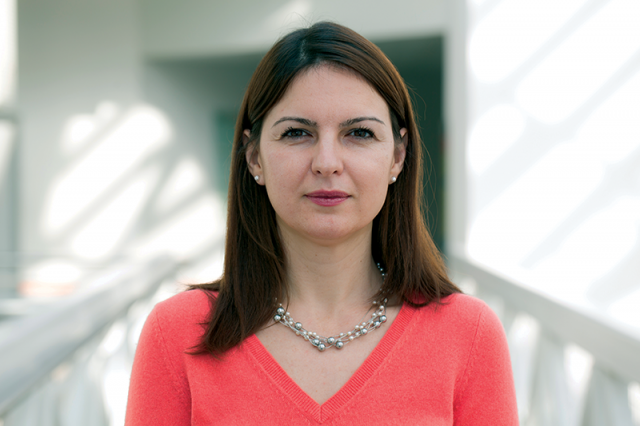At universities and in research institutes women are still a minority among group leaders and in managerial positions. One reason for this is gender bias. Dr. Klea Faniko, Senior Researcher in the Faculty of Psychology and Educational Sciences at the University of Geneva , suggests ways to improve gender equality in academia.
Dr Klea Faniko, could you define gender biases and give concrete examples of situations where they prevail?
At work, we encounter explicit and implicit gender biases. Explicit gender bias takes place when people (women or men), express the idea that women are inferior to men or that they are unable to perform at the same level as men. For instance, people consider that women are less ambitious, less committed to their career than men, and that they prioritize their family over their career. There is now a consensus in academia that such statements are scientifically unfounded. Nonetheless, it needs to be stressed that “off the records” they are still very present, even if they may be downplayed as “friendly jokes” or “locker-room talk”.
Implicit gender bias on the other hand implies that people unconsciously associate specific jobs with men, and only exceptionally with women. Implicit gender biases are built through many different mechanisms: by media showing images of scientists as men, by faculty having mostly male professors, by the working culture of many academic departments which fits easily to a man, and less easily to a woman. Even if there is an increasing number of women, who accept very flexible working hours and a lot of mobility, in term of expectations it is still much harder for a woman to explain to her relatives and friends that it is absolutely necessary that she spends night shifts in her lab or that her partner and children have to follow her to a remote campus. This kind of implicit expectations about gender roles are much more difficult to identify as such.
Besides gender bias what are the other causes that keep women in the middle of the professional pyramid? What relative importance would you give to each factor in the academic setting?
I think that gender socialisation practices (the process by which individuals are taught how to socially behave in accordance with their assigned gender, which is assigned at birth based on their biological sex), on one hand, and gender biases, on the other hand, are at the origin of other kinds of obstacles that women encounter at the University. A study (Faniko, 2016) conducted for the Equal Opportunity Office at the University of Geneva showed disparities in the treatment of women and men by their hierarchical superiors. Compared to male researchers, female researchers report experiencing more situations characterized by a lack of support on the part of their hierarchy (such as a lack of guidance), a lack of financing for research activities, and even a lack of promotion. Furthermore, data highlights the fact that parenthood can be an obstacle for woman’s career, not because women are unable to combine family with professional life, but because of the negative attitudes toward pregnancy. According to many interviewees, the fact that a female scientist may stay away from the lab during four months during her maternity leave is still considered as a sign that this woman is neglecting her career.
Compared to male researchers, female researchers report experiencing more situations characterized by a lack of support on the part of their hierarchy (such as a lack of guidance), a lack of financing for research activities, and even a lack of promotion.
Privilege is often invisible to those who have it until they come to realise it. How is gender inequality perceived by the academic leadership?
Privilege in academia may come from very different origins. Gender is one of them. Several studies show that being a man is a statistically robust and significant variable to explain one’s career chances in academia. Many informal professional networks are quite gender-specific. A new woman in the team is less likely to establish a close relationship with her male colleagues, possibly including the boss, through sports activities during lunch break, or through after-work beers. She will be therefore excluded from a lot of insider information. However, it needs to be stressed that there are also other sources of privilege. Other factors such as the social or cultural origin may play an important role. Scientists (men or women), who have relatives with a similar academic background or who can count on financial support from their family usually have much better chances to fulfil their professional ambitions.
What should imperatively happen in the workplace to take women to the top?
Mentoring programs and campaigns on stereotypes and sexual harassment are very good practices, but they cannot provide a fundamental change and correct the gender gap in academia. Setting binding gender quotas in faculties where there is a clear gender imbalance between the bottom and the top of the pyramid is the only effective approach to break the glass ceiling and to change the institutional culture. There are a lot of qualified women working at universities, who would perfectly fit these positions.
Can you give us some concrete examples of institutional measures or good practices taken toward gender equality?
I believe that the Equal Opportunity Office of the University of Geneva headed by Ms. Mantilleri provides a very good example of how to put in place practices aiming to achieve gender equality. This office is implementing different programs which boost women’s careers such as mentoring programmes for junior women as well as gender-specific scholarships and tenure-track positions. They manage to keep a lot of talented women in academia and to increase the share of female professors.
What could women do as individuals? What do they need to tell themselves, or tell the women that work with or for them or tell their daughters?
It is especially important for women to be self-confident and to believe that they can succeed in their career. Further, it is important to promote a professional environment that supports gender equality and good work-family balance. Women could take a lead in promoting role models and job models that enable young parents to consider a career without excluding a family life. Our study at the University of Geneva showed that many academically promising young mothers – but also many young fathers – drop out of academia because of a working environment that discourages parenthood. A family-friendly working environment is a key ingredient to make sure that the talents of both genders can be kept and promoted in academia.
From the numerous publications on the topic of gender bias which one would you recommend to our readers and why?
I would recommend different papers which can help people to be aware of the impact of gender bias on academia. For instance, the following papers show how gender bias negatively affect the evaluation of female researchers (Proudfoot et al., 2015; Leslie et al., 2015), their employability (Steinpreis et al., 1999; Moss-Racusin et al., 2012), their opportunity to get grants (Van der Lee & Ellemers, 2015), and the attitudes of women in senior positions toward other women (Faniko et al., 2017). For a deeper understanding of the situation in Switzerland, I would refer to our study carried at the University of Geneva (Faniko, 2016) and to an edited volume referring to gender and social hierarchies in the French speaking area of Switzerland (Faniko et al., 2015).
Why should we support gender equality in academia? How would society in general and academia in particular benefit from it?
First of all, it is a question of fairness and justice. Women and men have exactly the same intellectual capacities and the same career potential. The fact that many women face obstacles in their career path that men do not have to face is a major issue in social justice. Furthermore, there are currently more women than men in higher education, and at many departments there is also a majority of female PhD students and postdocs. The fact that many of these women drop out of academia before reaching the top implies that a lot of talent, in which we invested a lot of resources, will be wasted. In economic terms, it is a very bad deal to renounce to this return on investment. Last but not least, a growing body of research shows that teams with more gender diversity in leading positions lead to better performance (Peterson Institute for International Economics, 2016) and better science (Nielsen et al., 2017).
 Dr. Klea Faniko is Senior Lecturer and Researcher at the Faculty of Psychology and Education Science of the University of Geneva. After her PhD in Social Psychology from the University of Lausanne (Switzerland), she joined the University of Geneva and Leiden University (the Netherlands) as postdoctoral researcher, and Utrecht University (the Netherlands) as senior researcher. Her research interests focus on gender equality, women’s career and cultural diversity.
Dr. Klea Faniko is Senior Lecturer and Researcher at the Faculty of Psychology and Education Science of the University of Geneva. After her PhD in Social Psychology from the University of Lausanne (Switzerland), she joined the University of Geneva and Leiden University (the Netherlands) as postdoctoral researcher, and Utrecht University (the Netherlands) as senior researcher. Her research interests focus on gender equality, women’s career and cultural diversity.


Leave a comment
The editors reserve the right not to publish comments or to abridge them.